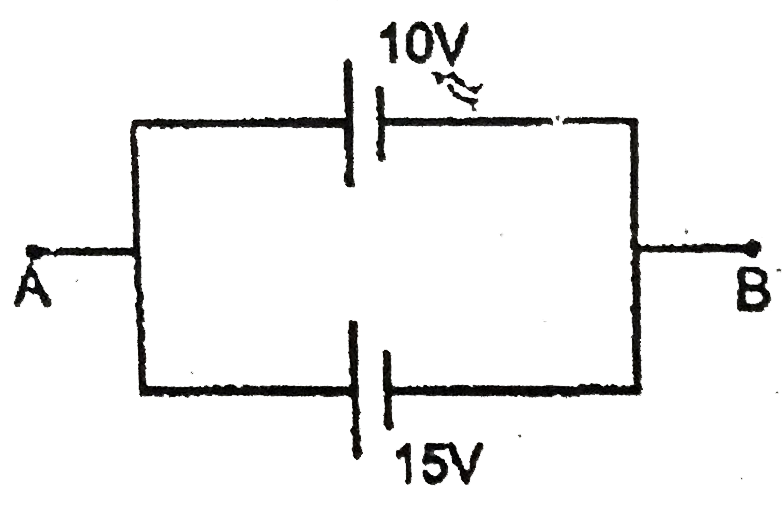Two nonideal batteries are connected in parallel. Consider the following statements:
(A)The equivalent emf is smaller than either of the two emfs.
(B) The equivalent internal resistance is smaller than either of the two internal resistances.
The equivalent emf is smaller than either of the two emfs
The equivalent5 internal resistance is smaler than either of the two internal resistances
B is correct b ut A is wrong
both A are B are wrong
The correct Answer is:3
To solve the problem regarding two non-ideal batteries connected in parallel, we will analyze the equivalent emf and equivalent internal resistance of the system.
1. Understanding the Configuration:
- We have two non-ideal batteries connected in parallel.
- Let the emf of the first battery be E1 and its internal resistance be R1.
- Let the emf of the second battery be E2 and its internal resistance be R2.
2. Finding the Equivalent Emf:
- The formula for the equivalent emf Eeq when two batteries are connected in parallel is given by:
Eeq=E1/R1+E2/R21/R1+1/R2
- This expression indicates that the equivalent emf depends on both the emfs and the internal resistances of the batteries.
3. Special Case:
- If both batteries have the same emf (i.e., E1=E2=E), the equivalent emf simplifies to:
Eeq=E⋅R1+R2R1+R2=E
- Thus, in this special case, the equivalent emf is equal to the emf of a single cell.
4. General Case:
- In the general case where E1 and E2 are not equal, the equivalent emf Eeq will still be less than the larger of the two emfs due to the division by the sum of the resistances in the denominator.
- Therefore, we can conclude that the equivalent emf is smaller than either of the two emfs.
5. Finding the Equivalent Internal Resistance:
- The equivalent internal resistance Req when batteries are connected in parallel is given by:
Req=R1R2R1+R2
- This formula shows that the equivalent internal resistance is always less than either R1 or R2 (as the product of resistances divided by their sum is always less than the smallest resistance).
6. Conclusion:
- From the analysis:
- Statement (A): The equivalent emf is smaller than either of the two emfs. True
- Statement (B): The equivalent internal resistance is smaller than either of the two internal resistances. True
Final Answer:
Both statements (A) and (B) are correct.
- We have two non-ideal batteries connected in parallel.
- Let the emf of the first battery be E1 and its internal resistance be R1.
- Let the emf of the second battery be E2 and its internal resistance be R2.
- The formula for the equivalent emf Eeq when two batteries are connected in parallel is given by:
Eeq=E1/R1+E2/R21/R1+1/R2
- This expression indicates that the equivalent emf depends on both the emfs and the internal resistances of the batteries.
- If both batteries have the same emf (i.e., E1=E2=E), the equivalent emf simplifies to:
Eeq=E⋅R1+R2R1+R2=E
- Thus, in this special case, the equivalent emf is equal to the emf of a single cell.
- In the general case where E1 and E2 are not equal, the equivalent emf Eeq will still be less than the larger of the two emfs due to the division by the sum of the resistances in the denominator.
- Therefore, we can conclude that the equivalent emf is smaller than either of the two emfs.
- The equivalent internal resistance Req when batteries are connected in parallel is given by:
Req=R1R2R1+R2
- This formula shows that the equivalent internal resistance is always less than either R1 or R2 (as the product of resistances divided by their sum is always less than the smallest resistance).
- From the analysis:
- Statement (A): The equivalent emf is smaller than either of the two emfs. True
- Statement (B): The equivalent internal resistance is smaller than either of the two internal resistances. True
Both statements (A) and (B) are correct.
Topper's Solved these Questions
Similar Questions
the two nonideal batteries are connected in series. Consider the following statements :
(A)The equivalent emf is larger than either of the two emfs.
(B) the equivalent internal resistances is smaller than either of the two internal resistances.
View Solutionthe nonideal batteries are connected in series. Consider the following statements :
(A)The equivalent emf is larger than either of the two emfs.
(B) the equivalent internal resistances is smaller than either of the two internal resistances.
View Solution
Knowledge Check
If n cells each of emf E and internal resistance rare connected in parallel, then the total emf and internal resistances will be
Aε,rnBε,nrCnε,rnDnε,nr
Assertion : Two non-ideal batteries are connected in parallel with same polarities on same: side. The equivalent emf is smaller than either of the two emfs.
Reason : Two non-ideal batteries are connected in parallel, the equivalent inter resistance is smaller than either of the two internal resistances.
View SolutionIf three cell are connected in parallel then equivalent emf……. and equivalent internal resistance is …..

View SolutionState how are the two resistors joined with a battery in each of the following cases when :
equivalent resistance is more than either of the two resistances.
View SolutionState how are the two resistors joined with a battery in each of the following cases when :
equivalent resistance is less than either of the two resistances,
View SolutionFind the equivalent emf and internal resistance of the arrangement shown in figure.

View SolutionThe equivalent resistance of two resistor connected in series is 6Ω and their equivalent resistance is 43Ω. What are the values of resistances ?
View SolutionTwo cells of e.m.f. 10V & 15V are connected in parallel to each other between points A&B. The cell of e.m.f. 10V is ideal but the cell of e.m.f. 15V has internal resistance 1Ω. The equivalent e.m.f. between A and B is:

View Solution
